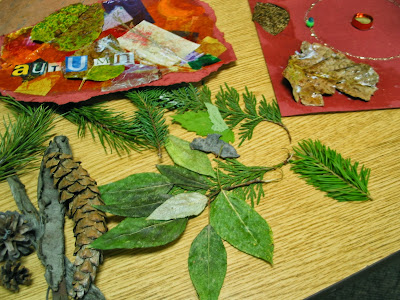“What I stand for is what I stand on.” ― Wendell Berry
 |
| Equinox egg-periment |
Monday, September 23:
introduction to the planets, autumnal equinox, egg experiment, fall art
(Sources: National Geographic Education: The Reasons for the Seasons, National Geographic video: Equinox, National Geographic Kids: Eggs-periment, Magic School Bus: Lost in the Solar System)
Grade Level: Elementary
Materials:
Magic School Bus: Lost in the Solar System, construction paper, flashlight, globe, egg, salt, National Geographic video: Equinox, collage materials)
Objective: Students will begin to understand the seasons and the role the equinoxes plays in the lunar year.
Class introduction/hook: Magic School Bus: Lost in the Solar System, Flashlight demonstration
M and I began class today by reading Magic School Bus: Lost in the Solar System aloud. We made a cozy space on the library floor to sit. We laughed at the characters and read all the reports that lined the sides of the pages.
The Magic School Bus: Lost in the Solar System is only indirectly related to what I wanted to explore with M today. I hoped to take advantage of the fall equinox as a way to talk about the science of seasons. M & M and I have focused the majority of our energy on ecology so far this year. We've talked about fungi, yeast, mushrooms, bread-baking, and trees. Very little of our discussion has veered toward space, the sun, or the solar system. It makes more sense to me to explore astronomy during the winter when its more difficult to hike but I didn't want to miss the opportunity to talk about the equinox. The Magic School Bus helped M and I built the vocabulary for that conversation.
After the story, M and I explored direct and indirect light using a flashlight demonstration. We turned off the library lights. I shone a flashlight on a piece of black construction paper.
"Is this direct or indirect light?" I asked M.
He paused, "Direct?"
I nodded. I tilted the flashlight so the glow grew dimmer. "What about this?"
"Indirect."
"Which light do you think is more like summer?"
He looked at me, then burst out: "Direct!"
We looked at the globe and the tilt of the earth it demonstrates. We used the globe and the concept of direct and indirect light to launch into a conversation about the angle of the earth as it orbits around the sun and the way that angle shapes the seasons. We talked about the northern and southern hemisphere and their opposite summer/winter schedule. We watched National Geographic video: Equinox.
I think M understood a lot about angle of the earth and the effect its orbit has on the seasons based on our conversation but to be honest, my goal as an educator for this series of concepts (the equinox, the earth's orbit around the sun, the angle of the earth and its effect on light and weather) has less to do with complete understanding and more to do with recognition and introduction. I want M to feel familiar with concepts so that later in school he's comfortable with science and the methods scientists use for exploration.
We finished our conversation about the equinox with an experiment and an art project. For the experiment, M worked to balance an egg on the table top using salt. There's an unproven theory that it's easier to balance an egg upright during the equinoxes. Most scientists remain skeptical but it was fun to test. M and I kept the egg in the library fridge so we can retest its balance in a couple weeks when the earth is in a slightly different spot in its orbit.
For our last activity M and I went outside to collect leaves and grasses to collage into autumn-inspired art. M used a protractor and created an orbit out of glue-gunned glitter. He made a sun from sequins, an earth from green and blue beads, and bordered his work with decoupaged leaves.
Washington State content areas covered:
EALR 2: Inquiry
Big Idea: Inquiry
Core Content: Conducting Investigations
Students know that:
-2-3 INQA Question: Scientific investigations are designed to gain knowledge about the natural world.
-2-3 INQB Investigate: A scientific investigation may include making and following a plan to accurately observe and describe objects, events, and organisms; make and record measurements, and predict outcomes.
-2-3 INQD Investigate: Simple instruments, such as magnifiers, thermometers, and rulers provide more information than scientists can obtain using only their unaided senses.
Students are expected to:
• Explain how observations can lead to new knowledge and new questions about the natural world.
• Work with other students to make and follow a plan to carry out a scientific investigation. Actions may include accurately observing and describing objects, events, and organisms; measuring and recording data; and predicting outcomes.
EALR 2: Inquiry
Big Idea: Inquiry
Core Content: Conducting Investigations
Students know that:
-2-3 INQA Question: Scientific investigations are designed to gain knowledge about the natural world.
-2-3 INQB Investigate: A scientific investigation may include making and following a plan to accurately observe and describe objects, events, and organisms; make and record measurements, and predict outcomes.
-2-3 INQD Investigate: Simple instruments, such as magnifiers, thermometers, and rulers provide more information than scientists can obtain using only their unaided senses.
Students are expected to:
• Explain how observations can lead to new knowledge and new questions about the natural world.
• Work with other students to make and follow a plan to carry out a scientific investigation. Actions may include accurately observing and describing objects, events, and organisms; measuring and recording data; and predicting outcomes.


No comments:
Post a Comment